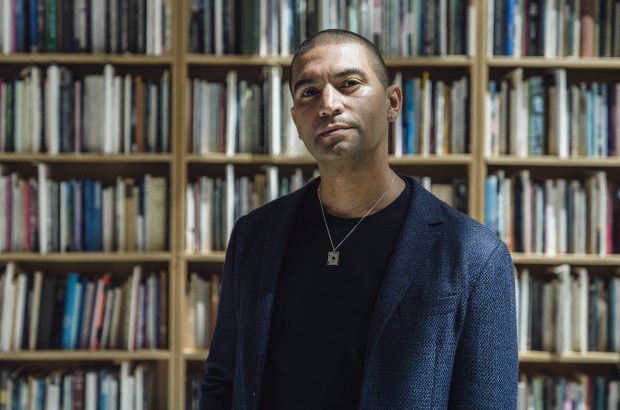What is a poet?
This is a question that I have been asking most of my life, since encountering poetry as a child and later in classrooms; in various taverns large and small and at the Green Mill where Marc Smith joyfully oversaw and orchestrated his creation called the poetry slam; in arenas that played host to the youngsters expressing themselves in Louder Than a Bomb competitions; and often in quiet rooms on a couch or a chair, a small book spread before me.
I have, in the course of this journey, met a lot of poets and though they are as varied in style, substance, sensibilities and talents as any group, they all seemed to share the ancient human need to be heard. They all, in various ways, operated under the shadow of these words, once spoken by the late poet David Hernandez, “Being a poet is an excuse to be a human being.”
So I was excited when I was asked to be Poetry Magazine’s guest editor for February, a relatively new monthly addition to this venerable publication.
Why me? Good question, but it likely has to do with my having known for many years Michelle Boone, who in 2021 became the first woman and African American to be president of the nonprofit Poetry Foundation, which publishes the magazine.
It also likely concerned my having recently interviewed the new editor of the magazine, a talented poet named Adrian Matejka. I also, even more recently, reviewed his new book, as I wrote, “a dynamic and unforgettable collaboration between artist Youssef Daoudi and writer Adrian Matejka. ‘Last On His Feet: Jack Johnson and the Battle of the Century’ is a wonder of words and images. It could be called a graphic novel if that description didn’t fail to fully capture its cinematically visual and literary substance.”
And so, when Robert Eric Shoemaker, the magazine’s digital archive editor, asked me to tackle this task, I thought, “Why not?”
We met. We talked. He told me my “job” would entail selecting from the treasure trove found at PoetryFoundation.org. I could select poems that had something to do with the month (Valentine’s Day, Black History) or in some other way — birth, death — had something to do with February.
There was a remuneration involved but I turned that down and just dove in. The looking was easy at this remarkable site, filled with surprises and discoveries.
Eventually, having read hundreds of poems, I selected these poets and poems: Lord Byron’s “She Walks in Beauty,” Dorothy Parker’s “Love Song,” Haki Madhubuti’s “Gwendolyn Brooks,” Patricia Smith’s “And then she owns you,” Robert Graves’ “A Valentine,” W.H. Auden’s “The More Loving One,” Margaret Atwood’s “February,” David Hernandez’s “We Would Never Sleep,” Gwendolyn Brooks’ “when you have forgotten Sunday: the love story,” and William Shakespeare’s Sonnet 116 “Let me not to the marriage of true minds.”
You can discover some of the reasons why I selected these poems by dipping into the essay that accompanies them. There is also a short video, made by Liz O’Connell-Thompson and Moyo Abiona.
In tackling this chore I was reminded not only what a joy there is in finding a new voice or hearing one long forgotten, but also what a remarkable thing Poetry Magazine has long been.
It was founded in 1912 — what a wild town this was then — by Harriet Monroe, who was an art critic for the Tribune. She famously described the magazine’s open-door policy. She said she wanted “to print the best English verse which is being written today, regardless of where, by whom, or under what theory of art it is written.”
She could afford to pay writers a measly 50 cents a line (actually not so measly since at the time that would buy you two pounds of coffee), but that didn’t prevent her from publishing in that first year the works of Vachel Lindsay, William Butler Yeats and Ezra Pound. The first published poetry of Carl Sandburg, “Chicago Poems,” made it into the March 1914 issue of the magazine, and T.S. Eliot made it in Poetry with his “The Love Song of J. Alfred Prufrock.”
Every great poet of the century (and some not so great) made it to the magazine’s pages, or tried to. One who never did was a woman named Ruth Lilly. For years she sent her poems to the magazine but none were ever accepted for publication. Still, she offered financial help, culminating with a stunning $200 million donation in 2002, seven years before her death.
The home of the foundation and magazine is at 61 W. Superior. Former Tribune architecture critic Blair Kamin wrote that it was a “splendid” building when it opened in 2011, “a mature work of architecture, one that, like fine poetry, is about subtle, slowly unfolding pleasures, not facile one-liners. It is, by turns, mysterious, engaging, richly layered and revealing.”
This is where Matejka, Shoemaker and their editorial colleagues read the 9,000-some submissions that arrive every month, sent in by poets across the planet.
rkogan@chicagotribune.com




